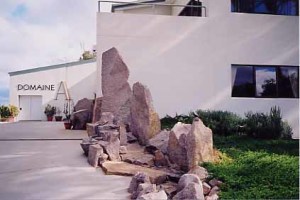
Domaine A / Stoney Vineyard winery
Barossa. McLaren Vale. Coonawarra, Margaret River. Most U.S. wine consumers are familiar with these names for they are the Australian wine regions which export abundantly overseas: those chesty Chardonnays and heady reds from Western Australia and the old- vine, warm-climate wines such as Shiraz (Syrah to us) from South Australia. But there is another fabled wine region, familiar to mainland Australians but little known to the rest of the world: Tasmania.
Situated some 150 miles southeast of the coast of Victoria, the island of Tasmania—roughly the size of West Virginia—is Australia’s smallest state, a veritable theme park for nature lovers, foodies, and oenophiles. With a third of the state safeguarded by World Heritage status, the sheer beauty and purity of the landscape and natural resources is staggering. In fact, Tasmania has measurably the cleanest air on the planet and the water is so pure that you can drink directly from streams and lakes in the national parks.
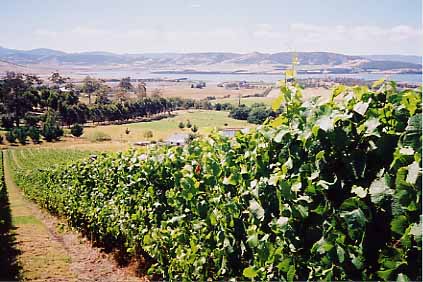
The landscape unfolds on a chromatic scale of green— citron, celery, sage, cypress—under aesthetically turbulent cloudscapes. As you drive through rolling hills and charming valleys there’s an overwhelming sense of artistic composition, of great spaces creatively presented in manageable eyefuls, as though you’re driving through an Italian Renaissance painting under an 18th century English sky. Land by Pinturicchio, sky by Turner or Constable. I’m told that in November the countryside is blanketed in stunning shades of pink and mauve…Tasmania grows 70% of the world’s legal opium!
And then there’s the wine: delicate, subtle, fragrant, with low alcohol and sulfite levels. No jammy, overly pungent, gamey whoppers here. “Our vines are 100% disease-free,” says Stuart Bryce, President of the Vineyards Association of Tasmania. “If you have perfect fruit, there is nothing you need to do to it.” Tasmanian winemakers will tell you that their wines are “less extracted, less manipulated.” But you will have to taste them on site, as Tasmania produces less than 1% of the total Australian crush. That’s one reason to come here; the currency is another. Since our dollar now buys two of theirs, the time has never been better to treat yourself to the ultimate “passport” experience.
Most tasting rooms (called cellar doors here) are open all year, but the mild Tasmanian summers, which unfold during our rainy winters, are an ideal time to visit. I happened to arrive in mid-February, just as Launceston’s 2-day Festivale was in full swing: a food, wine, and performing arts extravaganza that serves as a compendium of the state’s epicurean delights. The Festivale is slated for the second weekend in February and offers an excellent introduction to any wine tour.
In addition to the booths for ample sampling, there are serious food and wine “workshops” which, for example, “explore desserts as an exacting art form, as architectural offerings and aesthetic fantasies.” Best for my purposes was clearly the “Tasmanian Triangle” workshop wherein trios of Riesling, Gewürztraminer, and Pinot Gris—wines of the Alsace which also grow well in Tasmania—were matched with food samples. These pairings were quite seriously vetted by a trio of food and wine experts before a roomful of enthusiasts invited to join the discussion.
There’s a northern and southern wine route; I began in the north and worked my way south. This means flying into Launceston, a mere hour’s flight from Melbourne. Car rental at the airport is a snap and American drivers licenses are accepted. You might choose to spend a few nights in Launceston—there’s a terrific new railroad museum and an exhilarating furniture design center, not to mention Festivale—but I chose to drive directly to Riverbank Cottages, located 15 minutes north of the city. The serene cottages (there are only three, so reserve early) provide an ideal base from which to explore the east and west Tamar Valley regions; you’ll need one day for each. With the help of my gracious host, wine writer Tony Walker, and the excellent Wine Route maps, I was ready to set out.
I began my first day at Tamar Ridge Wines, a new and still expanding facility with the latest and largest equipment surrounding a spacious tasting counter. Gleaming, state of the art machinery whirs and clanks inside…outside, black swans float gracefully across the adjoining lake. All the wines here are worth tasting, if only to provide a benchmark for what you will sample in the days ahead. The Riesling is particularly good, bone dry and crisp as the first bite of a Golden Delicious. Small wonder that it has won gold medals in three consecutive vintages.
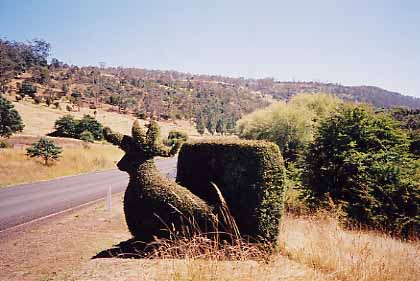
roadside topiary
At nearby Holm Oak Vineyards vigneron and winemaker Nicholas Butler has coaxed the grapes through 14 consecutive vintages. Three’s a crowd in the tiny tasting room, where Nick presides over superb Cabernets, a lovely Pinot Noir, and this region’s only rosé. It’s fun to visit these two wineries in tandem: one, modern and mechanized, the other tiny and artisanal, both offering superb product.
Just down the road from Holm Oak is Lavender House, where you can choose from a vast and sometimes unusual (Lavender scones?) inventory of lavender products and stroll through acres of fragrant fields. The entire southern hemisphere’s only commercially produced lavender comes from Tasmania and this is the state’s largest lavender plantation. Don’t miss this!
By now it’s time for lunch and you have two choices: Strathlynn, which is affiliated with Pipers Brook, Tasmania’s largest wine-making operation (you will visit it tomorrow), or the restaurant at Rosevears Estate Winery; both feature Tasmanian specialties served in gracious, spacious locations. At Rosevears Estate I had a superb quail salad with a dressing of apple vinaigrette and macadamia nuts. My entirely sufficient appetizer was a mere $7.25; a glass of outstanding ’99 Chardonnay with intense fruit and a lovely, lingering nose added another $3. I like the logo on the Rosevears bottles: a jester juggling the elements—soil, weather, birds— which in turn symbolizes the unpredictable highs and lows of the always capricious wine cycle.
Strathlynn’s kitchen is headed by chef Daniel Alps, known for his sold-out classes on “the best of the Tamar,” featuring local products and the stories behind them. His master classes are held in May and August but with sufficient advance notice, private classes can be arranged.
On Day Two I set off immediately for Pipers Brook, Tasmania’s pre-mier wine estate and the only one to export worldwide. Founded 25 years ago by Dr. Andrew Pirie, PB produces a superb, tender yet tart Chardonnay, as well as a lovely, fragrant Riesling and the world-class Pirie sparkling wine. Andrew insists that his approach to winemaking is unique because “it captures the flavors of Tasmania’s ‘terroir’—clear, vibrant, New World taste—but presents them within a rather old-world, grown-up and food-friendly structure; this, we hope, gives us the best of the two hemispheres combined.”

Ornee Cottage in Campbell Town…built in the 1830’s
Make sure you leave enough time to sample the magnificent, herbacious Sauvignon Blanc and the big, robust Pinot Noir (for sale at an incredible $10) at nearby Dalrymple Vineyard. The Pinot features sweet cherry and plum over French oak with good tannins and a tart yet amiable finish. And, though I’m not truly fond of sparkling wines, the ’98 Blanc de Blanc is very good, with creamy texture, lifting acid, and small bead. The unwooded Chardonnay is a great value-for- price at $7.50. In short, try every thing.
Next stop: Brook Eden Vineyard in Lebrina, featuring the region’s only Pinot Noir aged in American oak. Tasmanian winemakers prefer French oak for its greater “virility;” they feel the vanillin in American oak lends too much sweetness…I don’t agree: the 2000 Pinot Noir (reserve) here was one of my favorites.
Still in Lebrina: Clover Hill Vineyards, home to my favorite sparkling wine: an elegant, beguiling blend of 24% Pinot Noir, 63% Chardonnay, and 13% Pinot Meunier grapes. Oak matured reserves are combined with young base wines, placed on extended (minimum two years) maturation on yeast lees, disgorged, then aged on cork. The bubbles are just right, ditto the creamy mouth feel and structured finesse of this wine whose pear/citrus/apple aromas yield to a toasty, gently yeasty finish. Simply awesome.
And what better way to finish the day than with a visit to Tasmania’s oldest vineyard which happens to be home to Stuart Bryce, President of the VAT. Providence Vineyard began its existence in 1956 as La Provence but underwent a name change in the ‘90s following an extended legal battle with the French, who claimed the winery was pretending its wines were French! Hardly. In addition to his own Riesling and Chardonnay, Stuart also carries other Tasmanian wines, making this a perfect stop for concluding the northern wine route.
For dinner I returned to Launceston to sample the superb fare at Stillwater, an 1830’s flourmill which has been transformed into one of Tasmania’s premier restaurants with a wine cellar to match. Chef Don Cameron’s signature entrée (in Australia, this is the appetizer; our “entrées” are their “mains”) is a tasty treat delight of escalating seafood combinations culminating in calamari shavings flavored with ginger, coriander, and chili.
Warm ocean trout on dressed cucumber noodles swims softly around your mouth; my taste buds boomed and bloomed from the shredded duckling tartlet with leek fondue, red braised shallots, sherry vinegar caramel, pounded rocket (arugula), and caper sauce. Australia’s version of “PC” is to be “multi-culti” and Stillwater provides a culinary version in the form of braised Flinders Island lamb with Chinese red dates and Vietnamese mint. This is food as adventure: exciting, surprising, enriching. And the exchange rate gives U.S. visitors the privilege of memorable meals at reasonable, not treasonable, prices.
En route to the southern wine region, I dawdled in the pretty colonial towns that dot the Heritage Highway. I especially enjoyed the Wool Centre in Ross, “Tasmania’s Finest Heritage Village,” where you can plunge your hands into various grades of merino…and then see the real thing when you’re back on the road.
It took me three hours to drive from Launceston to Moorilla Estate, just outside Hobart, where very fine wines may be enjoyed along with “museum-quality antiquities.” I was frankly skeptical about this combination but am pleased to admit that I was wrong: there are wonderful collections of everything from Saracen coins and African Djenne masks to Roman mosaics and pre-Columbian metates (grinding stones), all housed in a building very much like a miniature Getty.
Moorilla also happens to have comfortable, spacious chalets (but only four) with stunning views of the Derwent River and Mt. Direction. Best of all, Moorilla’s winemaker, Mike Glover, will give you the ultimate winery tour: a lengthy, detailed, tasting and explanation of the wines he currently has “under construction.” Samples extracted from various barriques (small barrels) allow you to experience how a Pinot, say, is actually constructed, how the spine of the wine is married to the lush velvet attributes maturing in another barrel, which in turn are modified by the mid-palate pleasing qualities from yet another. Mike is quick to point out the one problem he sees with Tassie drinking habits, “99% of the wine produced here is for immediate consumption” which is possible because, with more natural fruit, wines need less time on oak. Still, says Mike, “I want to build more complex wines and educate the public to cellar cases instead of drinking their purchases within the year.” Sounds like a luxury worry to me!
Since the southern wine region is geographically more extensive than the northern one, time permitted only brief visits to several vineyards in the Coal River and Derwent valleys; the Huon Valley and Tasman Peninsula will have to wait until my next visit.
Using the Southern Wine Route map I quickly found Craigow, a delightful small winery which offers several tasting options: from the usual stand-at-the-counter sampling to a sit-down tasting with three-cheese assortment for $3.50. Tasmanian cheeses rate an article of their own…suffice it to say that the dairy products here are as nuanced as the wines and they complement each other perfectly. Craigow’s 2000 Riesling at $9.00 is my pick for best Riesling in its price category and was voted one of Australia’s Top Ten Rieslings in the latest edition of James Halliday’s 2002 Australia and New Zealand Wine Companion. At $11 the 2000 Chardonnay is another winner and will appeal to American palates accustomed to smoky, oaky Chardonnays…this one spent six months in new French oak yet maintains the delicate peach and citrus aromas characteristic of Tasmanian whites. Craigow is also unique in offering an excellent cup of coffee, a Very Good Idea, in my opinion.
Just down the road is Meadowbank, a much larger operation offering wine tasting, function facilities, a quite good restaurant, an art and sculpture gallery, sweeping views…it’s not hard to see why Meadowbank was voted “best tourism winery” in 2001. It can get crowded here, as it’s a favorite of bus tours, but still worth a stop alone for the superb ’99 unwooded Chardonnay ($12) which, with only 20 parts/million sulfite will appeal to those who cannot tolerate preservatives.
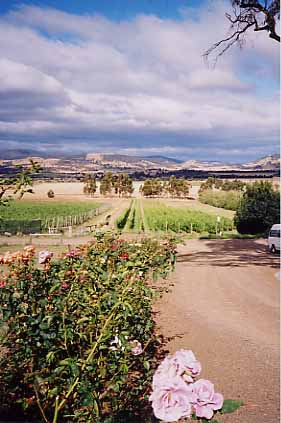
Domaine A / Stoney Vineyard
Finally, my favorite winery of the entire trip: Domaine A/ Stoney, a gem inside and out. Since 1989 Peter Althaus has been the sole winemaker, personally selecting the fruit for harvesting, These wines are made only from grapes cultivated on site: Cabernet Sauvignon, Cabernet Franc, Merlot, Petit Verdot, Pinot Noir, and the white grape Sauvignon Blanc. From this last Peter has created a Fumé Blanc which was my personal favorite of the entire trip: the ’99 Lady A Fumé Blanc, a wine Peter made specifically for his wife Ruth, is delicate as peach skin yet outspoken as a bird in song with that smoky edge which pulls Fumé so beautifully into the mouth. This is simply as perfect as a white can get! The Domaine A ’98 Pinot Noir is also worth the trip. No, unfortunately, these wines are not exported (except to Connecticut), although they are available in the rest of Australia.
The winery itself is beautiful: Persian carpets and comfortable Swiss chalet style furnishings invite the visitor to linger. If you want to learn more, ask for their newsletter, Tête A Tête, which contains excellent information about all the wineries in the Coal River region.
With four new vineyards under development, the Coal River Valley is about to explode: by 2005 this region will have quadrupled the land under vine, making this Tasmania’s largest wine region. Californian Tony Scherer, who lived in Santa Cruz for over twenty years while teaching organic agriculture at Cabrillo College, has set up Frogmore Creek, Tasmania’s first certified organic winery. His 40 acres of Pinot and Riesling is available in some San Francisco Bay Area restaurants and Whole Food Markets.
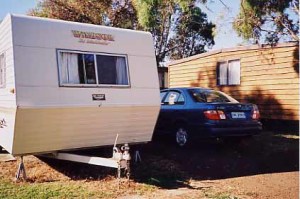
Caravan rental and a rental car
It was time, alas, to leave. Retracing my route along the Heritage Highway, I selected Richmond as the spot to spend Saturday night. Confident that I would find a B&B, I was surprised to learn that all available beds had been spoken for. Of course! Richmond is half an hour from Hobart and simply oozes charm. What to do? Inquire at the local pub. Here, a young lass suggested I try the caravan park. “But I don’t have a caravan,” I said. “You don’t need one,” she replied to what was clearly a daft American. Indeed, Australian caravan (trailer, RV) parks rent out “site vans” which come equipped with all but linens. Facilities were at the “toilet block,” which turned out to be gleamingly clean, as was the wee van, nary a bug or beastie, not even a mosquito. The managers, Bruce and Zofia, were kind enough to throw in towel, sheets, even a doona for the clueless visitor. At $17.50 per night, this was THE bargain of the trip…I slept so well that I stayed two nights.
From Moorilla’s 5-star chalets to Richmond’s simple site vans and all the colonial B&Bs in between, Tassie accommodations are as varied yet singular and superb as the air, food, and wine.
If you go……
RESOURCES
Excellent overview with helpful links.
Flies 3+ times daily between Melbourne or Sydney and Hobart or Launceston; check the site for E-deal specials.
For the latest information on Festivale and other Launceston events.
Coal River Wine Tours – personalized for you by the knowledgable and affable Gavin Shaw, PO.Box 924, Rosny Park 7018, Email: crvwinetour@bigpond.com
LODGING
All prices given below are in U.S. dollars, but please remember that those posted on websites will be in Australian dollars, US$1= (approx. AUS$2).
Fiona’s – 5/141a George St., Launceston 7250, 61 3 6334 5965; fax 6331 1709 ($36 single/$48 double).
The Maldon – 32 Brisbane St., Launceston 7250, 61 3 TOURS 6331 3211; fax 6334 4641($44 single/$50 double).
As you will be imbibing and driving on the other side of the road, you might opt for a tour….
Hamilton’s Tasmania Discoveries, www.hamiltonstours.com
tel: 61 3 62 503 230 fax: 61 3 62 503 406
Limousine Tours – exclusive yet affordable: 4 Carmen Court, Hadspen 7290, tel 61 417 598 351.
Fiona’s has wonderful views overlooking the city, The Maldon is a charming 4-star “Victorian accommodation.” At both the price includes a generous cooked breakfast.
The Stables – 5 Russell St., Evandale, 7212, www.vision.net.au/~thestables
If you arrive directly from the US and are so exhausted you cannot contemplate even the trip into Launceston, then a night in one of these charming, quiet cottages will be perfect; located 5 minutes from the airport, 15 minutes from Launceston ($50 single/$60 double).
Riverbank Cottages – 1325 East Tamar Highway, Dilston 7252. www.riverbankcottages.com.au
Colonial Cottages of Ross – 12 Church St., Ross 7209, mjohnson@southcom.com.au
Moorilla Estate – 655 Main Road, Berriedale 7011, www.moorilla.com.au
ATTRACTIONS
Tasmanian Wool Centre – Church St., Ross, 7209 www.taswoolcentre.com.au, open daily except Christmas Day & Good Friday.
Lavender House – 690 Rowella Rd., Rowella 7270, open daily 10am – 5 pm; closed June, July, Christmas Day & Good Friday.
Daniel Alps at Strathlynn, 95 Rosevears Drive, Rosevears 7277, Email: strathlynn@pbv.com.au
Stillwater – Ritchies Mill, 2 Bridge Rd., Launceston 7250, Email: stillwater@microtech.com.au
